What Is a Business Case?
A business case is a project management document that explains how the benefits of a project outweigh its costs and why it should be executed. Business cases are prepared during the project initiation phase and their purpose is to include all the project’s objectives, costs and benefits to convince stakeholders of its value.
A business case is an important project document to prove to your client, customer or stakeholder that the project proposal you’re pitching is a sound investment. Below, we illustrate the steps to writing one that will sway them.
The need for a business case is that it collects the financial appraisal, proposal, strategy and marketing plan in one document and offers a full look at how the project will benefit the organization. Once your business case is approved by the project stakeholders, you can begin the project planning phase.
When Should You Write a Business Case?
Around 70 percent of businesses that survive longer than five years follow a strategic business plan. And every project an organization undertakes should demonstrate real business value via a business case. A business case is created during the initiation phase of a project. At this point, the project is being conceptualized and evaluated on what the potential return on investment could be. The business case document helps determine the project’s needs and allows decision-makers to determine if the project aligns with the organization’s strategic goals.
For example, a business case may be used when there’s a new project proposal, when entering into a new market, when upgrading software solutions or when there’s a major capital expenditure. Once the business case has been approved, the project will move to the planning phase.
Why Is It Important to Write a Business Case Document?
A business case document benefits projects for several reasons.
- Justifies why a project is needed, outlining costs, benefits and risks
- Engages stakeholders and gets their buy-in and support
- Allows decision-makers to assess feasibility and make choices based on data
- Provides estimates for costs, resources and timelines to improve resource allocation
- Helps hold teams accountable for delivering on commitments
Overall, it helps guide the project initiation and execution to result in thoughtful and strategic decisions.
Business Case Template
Our business case template for Word is the perfect tool to start writing a business case. It has 9 key business case areas you can customize as needed. Download the template for free and follow the steps below to create a great business case for all your projects.

How to Write A Business Case
Projects fail without having a solid business case to rest on, as this project document is the base for the project charter and project plan. But if a project business case is not anchored to reality, and doesn’t address a need that aligns with the larger business objectives of the organization, then it is irrelevant.
The research you’ll need to create a strong business case is the why, what, how and who of your project. This must be clearly communicated. The elements of your business case will address the why but in greater detail. Think of the business case as a document that is created during the project initiation phase but will be used as a reference throughout the project life cycle.
Whether you’re starting a new project or mid-way through one, take time to write up a business case to justify the project expenditure by identifying the business benefits your project will deliver and that your stakeholders are most interested in reaping from the work. The following four steps will show you how to write a business case.
Step 1: Identify the Business Problem
Projects aren’t created for projects’ sake. They should always be aligned with business goals. Usually, they’re initiated to solve a specific business problem or create a business opportunity.
You should “Lead with the need.” Your first job is to figure out what that problem or opportunity is, describe it, find out where it comes from and then address the time frame needed to deal with it.
This can be a simple statement but is best articulated with some research into the economic climate and the competitive landscape to justify the timing of the project.
Step 2: Identify the Alternative Solutions
How do you know whether the project you’re undertaking is the best possible solution to the problem defined above? Naturally, prioritizing projects is hard, and the path to success is not paved with unfounded assumptions.
One way to narrow down the focus to make the right solution clear is to follow these six steps (after the relevant research, of course):
- Note the alternative solutions.
- For each solution, quantify its benefits.
- Also, forecast the costs involved in each solution.
- Then figure out its feasibility.
- Discern the risks and issues associated with each solution.
- Finally, document all this in your business case.
Step 3: Recommend a Preferred Solution
You’ll next need to rank the solutions, but before doing that it’s best to set up criteria, maybe have a scoring mechanism such as a decision matrix to help you prioritize the solutions to best choose the right one.
Some methodologies you can apply include:
- Depending on the solution’s cost and benefit, give it a score of 1-10.
- Base your score on what’s important to you.
- Add more complexity to your ranking to cover all bases.
Regardless of your approach, once you’ve added up your numbers, the best solution to your problem will become evident. Again, you’ll want to have this process also documented in your business case.
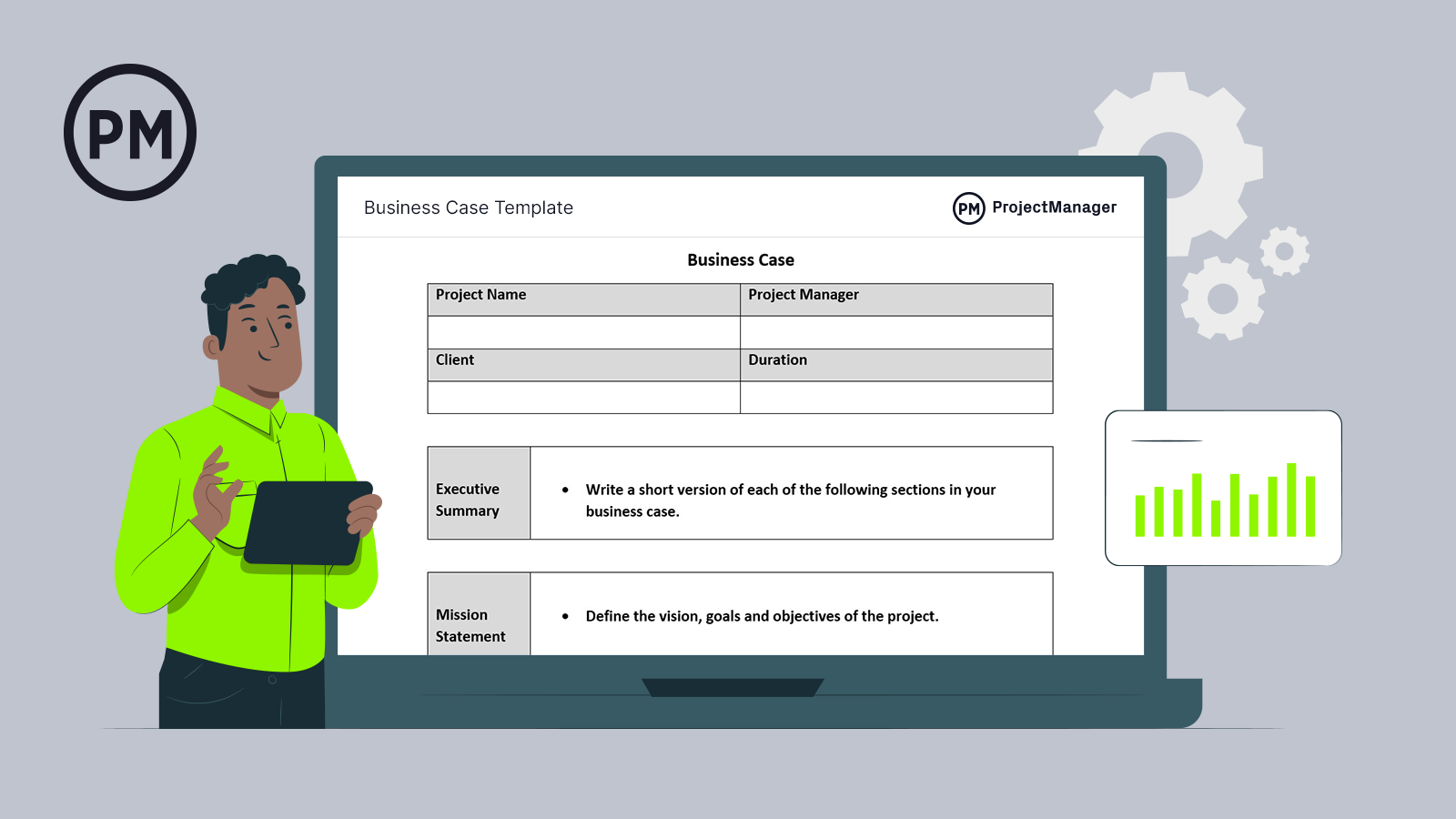
Get your free
Business Case Template
Use this free Business Case Template for Word to manage your projects better.
Step 4: Describe the Implementation Approach
So, you’ve identified your business problem or opportunity and how to reach it, now you have to convince your stakeholders that you’re right and have the best way to implement a process to achieve your goals. That’s why documentation is so important; it offers a practical path to solve the core problem you identified.
Now, it’s not just an exercise to appease senior leadership. Who knows what you might uncover in the research you put into exploring the underlying problem and determining alternative solutions? You might save the organization millions with an alternate solution than the one initially proposed. When you put in the work on a strong business case, you’re able to get your sponsors or organizational leadership on board with you and have a clear vision as to how to ensure the delivery of the business benefits they expect.
Key Elements of a Business Case
One of the key steps to starting a business case is to have a business case checklist. The following is a detailed outline to follow when developing your business case. You can choose which of these elements are the most relevant to your project stakeholders and add them to our business case template. Then once your business case is approved, start managing your projects with a robust project management software such as ProjectManager.
1. Executive Summary
The executive summary is a short version of each section of your business case. It’s used to give stakeholders a quick overview of your project to help them understand the project’s purpose, benefits and implications. Some components of an executive summary include the project overview, business need, proposed solution to the need, cost estimate, return on investment, risks, timeline and a call to action.
2. Project Definition
This section is meant to provide general information about your projects, such as the business objectives that will be achieved and the project plan outline. It offers a comprehensive overview of the project including its objectives and scope. Here, include details such as the objectives, stakeholders, scope, expected outcomes and constraints.
3. Vision, Goals and Objectives
First, you have to figure out what you’re trying to do and what is the problem you want to solve. You’ll need to define your project vision, goals and objectives. This will help you shape your project scope and identify project deliverables.
4. Project Scope
The project scope determines all the tasks and deliverables that will be executed in your project to reach your business objectives. Think of it as establishing the project’s boundaries to help stakeholders better understand what to expect. A well-defined scope can also improve resource allocation and project planning, two key factors of the project’s long-term success.
5. Background Information
Here you can provide a context for your project, explaining the problem that it’s meant to solve, and how it aligns with your organization’s vision and strategic plan.
6. Success Criteria and Stakeholder Requirements
Depending on what kind of project you’re working on, the quality requirements will differ, but they are critical to the project’s success. Collect all of them, figure out what determines if you’ve successfully met them and report on the results.
7. Project Plan
It’s time to create the project plan. Figure out the tasks you’ll have to take to get the project done. You can use a work breakdown structure template to make sure you are through. Once you have all the tasks collected, estimate how long it will take to complete each one.
Project management software makes creating a project plan significantly easier. ProjectManager can upload your work breakdown structure template and all your tasks are populated in our tool. You can organize them according to your production cycle with our kanban board view, or use our Gantt chart view to create a project schedule.
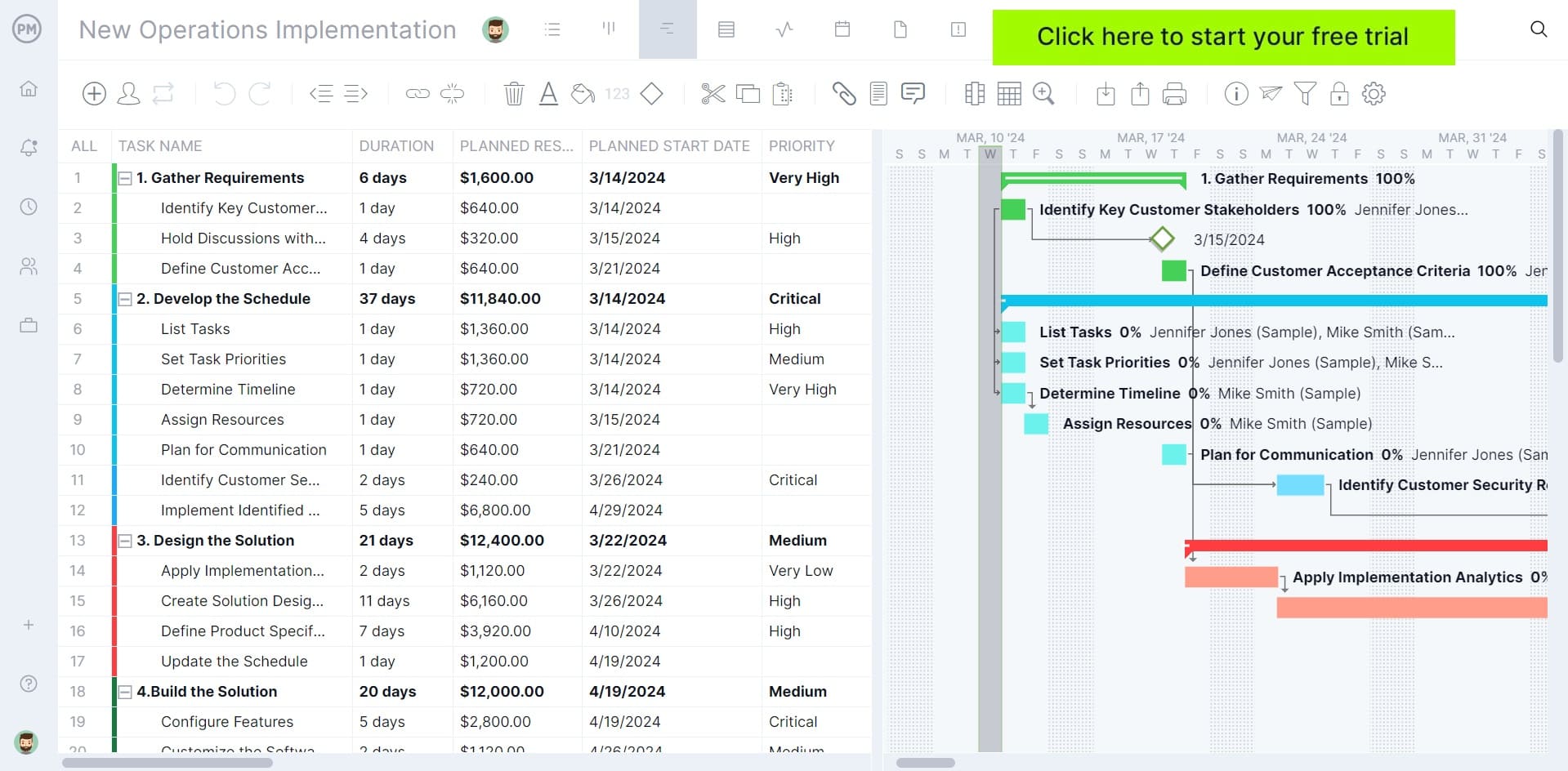
8. Project Budget
Your budget is an estimate of everything in your project plan and what it will cost to complete the project over the scheduled time allotted. It outlines the financial resources such as personnel costs, software or hardware costs, consulting fees, training costs and contingency funds. It also provides the return on investment information and shows how the benefits will outweigh the costs.
9. Project Schedule
Make a timeline for the project by estimating how long it will take to get each task completed. For a more impactful project schedule, use a tool to make a Gantt chart, and print it out. This will provide that extra flourish of data visualization and skill that Excel sheets lack.
10. Project Governance
Project governance refers to all the project management rules and procedures that apply to your project. For example, it defines the roles and responsibilities of the project team members and the framework for decision-making.
11. Communication Plan
Have milestones for check-ins and status updates, as well as determine how stakeholders will stay aware of the progress over the project life cycle. The communication plan can help foster an atmosphere of transparency and engagement among stakeholders. The plan outlines how, when and what will be communicated so that everyone is informed and on the same page.
12. Progress Reports
Have a plan in place to monitor and track your progress during the project to compare planned to actual progress. There are project tracking tools that can help you monitor progress and performance.
Again, using a project management tool improves your ability to see what’s happening in your project. ProjectManager has tracking tools like dashboards and status reports that give you a high-level view and more detail, respectively. Unlike light-weight apps that make you set up a dashboard, ours is embedded in the tool. Better still, our cloud-based software gives you real-time data for more insightful decision-making. Also, get reports on more than just status updates, but timesheets, workload, portfolio status and much more, all with just one click. Then filter the reports and share them with stakeholders to keep them updated.
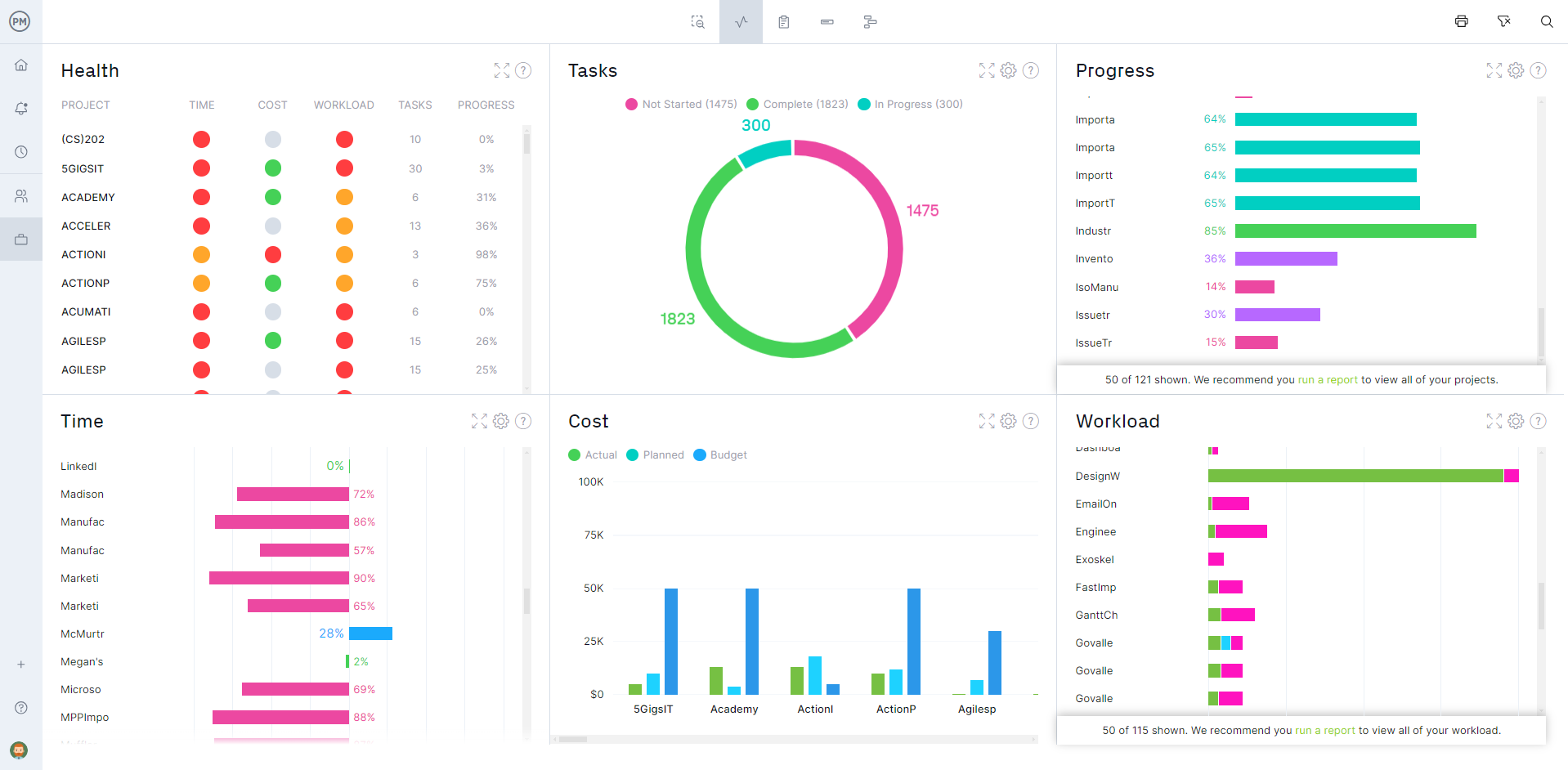
13. Financial Appraisal
This is a very important section of your business case because this is where you explain how the financial benefits outweigh the project costs. Compare the financial costs and benefits of your project. You can do this by doing a sensitivity analysis and a cost-benefit analysis.
14. Market Assessment
Research your market, competitors and industry, to find opportunities and threats. The market assessment can also help outline the overall market condition and how that could impact the project. For example, what are the current market needs and trends? Are there any barriers to entry that could impact the project such as strong competition or high capital requirements? Note all of this information in this section of the business case.
15. Competitor Analysis
Identify direct and indirect competitors and do an assessment of their products, strengths, competitive advantages and their business strategy. For example, how does each competitor position itself in the market? What pricing strategy do they implement and where is there room for differentiation? Then, use this information to help guide future decisions.
16. SWOT Analysis
A SWOT analysis helps you identify your organization’s strengths, weaknesses, opportunities and threats. The strengths and weaknesses are internal, while the opportunities and threats are external. This is a structured approach to help stakeholders make more informed decisions and outlines how to better leverage internal and external resources. The SWOT analysis helps ensure that the project aligns with organizational goals and market conditions.
17. Marketing Strategy
Describe your product, distribution channels, pricing, target customers among other aspects of your marketing plan or strategy.
18. Risk Assessment
There are many risk categories that can impact your project. The first step to mitigating them is to identify and analyze the risks associated with your project activities. From there, you can assess the likelihood and impact of each and rank them based on this information. The risk assessment makes it easier to focus on the most pressing risks and includes a mitigation strategy to reduce the impact in case the risk comes to fruition.
How ProjectManager Helps with Your Business Case
ProjectManager, an award-winning project management software, can collect and assemble all the various data you’ll be collecting, and then easily share it both with your team and project sponsors.
Once you have a spreadsheet with all your tasks listed, you can import it into our software. Then it’s instantly populated into a Gantt chart. Simply set the duration for each of the tasks, add any dependencies, and your project is now spread across a timeline. You can set milestones, but there is so much more you can do.
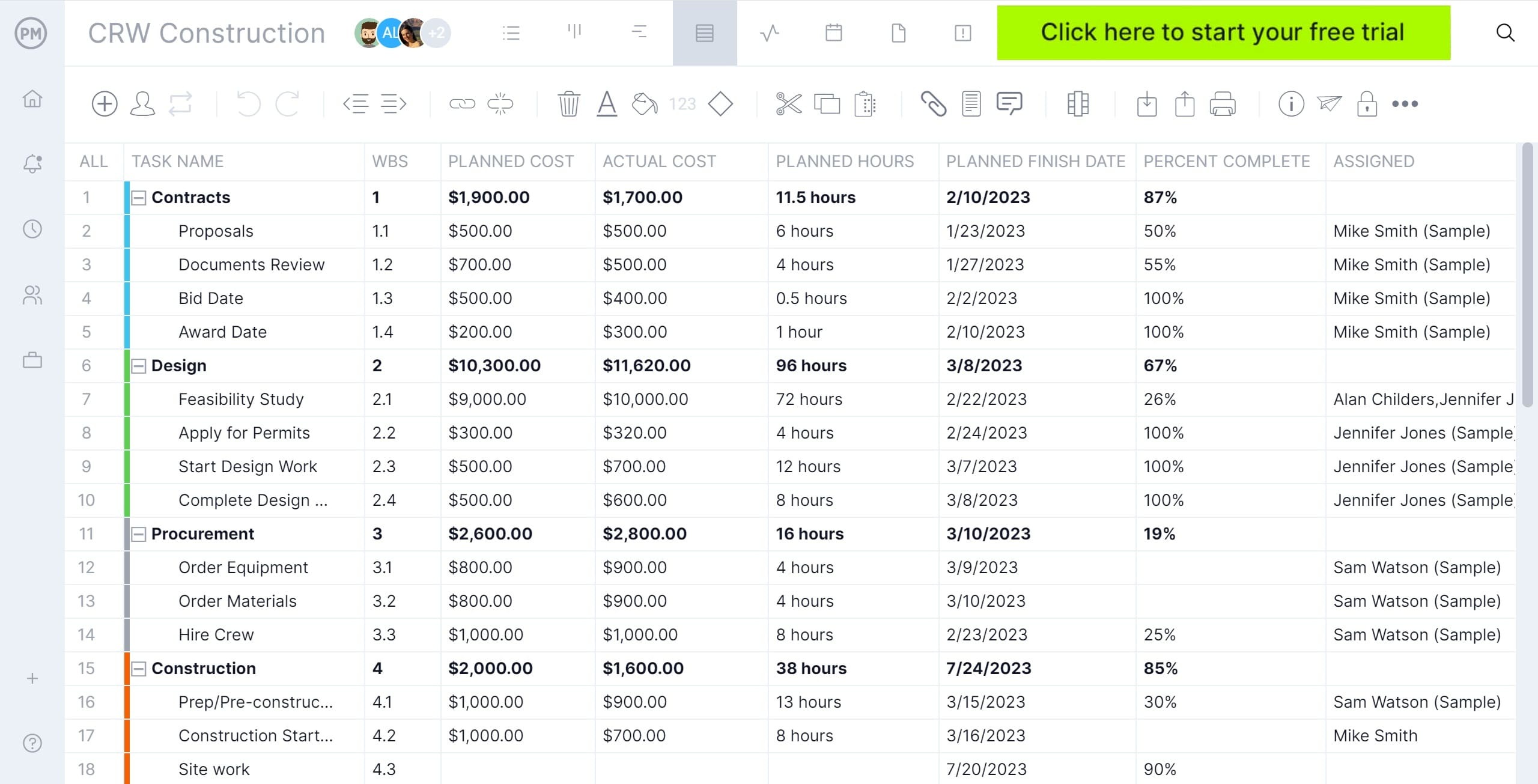
You have a project plan now, and from the online Gantt chart, you can assign team members to tasks. Then they can comment directly on the tasks they’re working on, adding as many documents and images as needed, fostering a collaborative environment. You can track their progress and change task durations as needed by dragging and dropping the start and end dates.
But that’s only a taste of what ProjectManager offers. We have kanban boards that visualize your workflow and a real-time dashboard that tracks six project metrics for the most accurate view of your project possible.
Try ProjectManager and see for yourself with this 30-day free trial.
Watch Our Business Case Training Video
If you want more business case advice, take a moment to watch Jennifer Bridges, PMP, in this short training video. She explains the steps you have to take in order to write a good business case.
Here’s a screenshot for your reference.
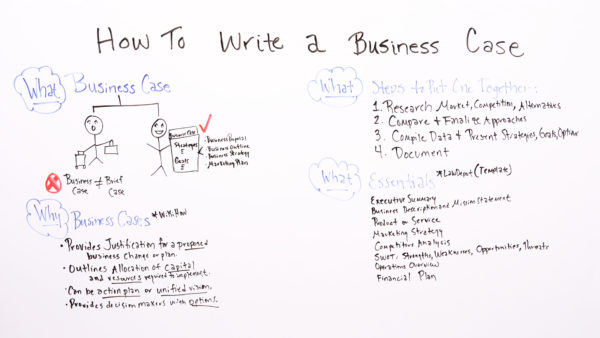
Transcription:
Today we’re talking about how to write a business case. Well, over the past few years, we’ve seen the market, or maybe organizations, companies or even projects, move away from doing business cases. But, these days, companies, organizations, and those same projects are scrutinizing the investments and they’re really seeking a rate of return.
So now, think of the business case as your opportunity to package your project, your idea, your opportunity, and show what it means and what the benefits are and how other people can benefit.
We want to take a look today to see what’s in the business case and how to write one. I want to be clear that when you look for information on a business case, it’s not a briefcase.
Someone called the other day and they were confused because they were looking for something, and they kept pulling up briefcases. That’s not what we’re talking about today. What we’re talking about are business cases, and they include information about your strategies, about your goals. It is your business proposal. It has your business outline, your business strategy, and even your marketing plan.
Why Do You Need a Business Case?
And so, why is that so important today? Again, companies are seeking not only their project managers but their team members to have a better understanding of business and more of an idea business acumen. So this business case provides the justification for the proposed business change or plan. It outlines the allocation of capital that you may be seeking and the resources required to implement it. Then, it can be an action plan. It may just serve as a unified vision. And then it also provides the decision-makers with different options.
So let’s look more at the steps required to put these business cases together. There are four main steps. One, you want to research your market. Really look at what’s out there, where are the needs, where are the gaps that you can serve? Look at your competition. How are they approaching this, and how can you maybe provide some other alternatives?
You want to compare and finalize different approaches that you can use to go to market. Then you compile that data and you present strategies, your goals and other options to be considered.
And then you literally document it.
So what does the document look like? Well, there are templates out there today. The components vary, but these are the common ones. And then these are what I consider essential. So there’s the executive summary. This is just a summary of your company, what your management team may look like, a summary of your product and service and your market.
The business description gives a little bit more history about your company and the mission statement and really what your company is about and how this product or service fits in.
Then, you outline the details of the product or service that you’re looking to either expand or roll out or implement. You may even include in their patents may be that you have pending or other trademarks.
Then, you want to identify and lay out your marketing strategy. Like, how are you gonna take this to your customers? Are you going to have a brick-and-mortar store? Are you gonna do this online? And, what are your plans to take it to market?
You also want to include detailed information about your competitor analysis. How are they doing things? And, how are you planning on, I guess, beating your competition?
You also want to look at and identify your SWOT. And the SWOT is your strength. What are the strengths that you have in going to market? And where are the weaknesses? Maybe some of your gaps. And further, where are your opportunities and maybe threats that you need to plan for?
Then the overview of the operation includes operational information like your production, even human resources, information about the day-to-day operations of your company.
And then, your financial plan includes your profit statement, your profit and loss, any of your financials, any collateral that you may have, and any kind of investments that you may be seeking.
Related Project Planning Content
- Project Documentation: 15 Essential Project Documents
- How to Create a Project Execution Plan (PEP)
- How to Write a Scope of Work
- Project Scope Statement: How to Write One With Examples
So these are the components of your business case. This is why it’s so important. And if you need a tool that can help you manage and track this process, then sign up for our software now at ProjectManager.

